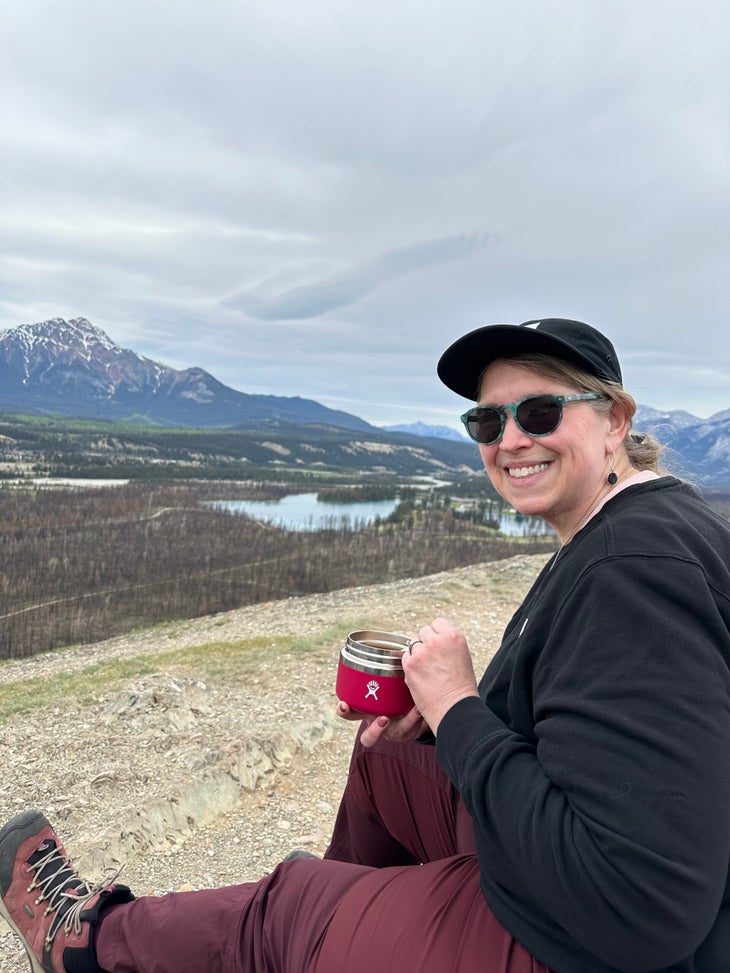“], “filter”: { “nextExceptions”: “img, blockquote, div”, “nextContainsExceptions”: “img, blockquote, a.btn, a.o-button”} }”>
Heading out the door? Read this article on the new Outside+ app available now on iOS devices for members!
>”,”name”:”in-content-cta”,”type”:”link”}}”>Download the app.
From the Old Fort Point Loop Trail overlooking Jasper, Alberta, Nicolas Gosselin shows me the epicenter of the 2024 Jasper wildfire, where two lightning strikes within 20 seconds on opposite sides of the valley set the surrounding forest ablaze last July. Those strikes catapulted into a firestorm with a direct path toward the Canadian Rockies town.
The fire hopscotched, creating its own weather systems with winds greater than 200 mph. Conditions worsened, leading to “firenados” that eventually decimated 81,545 acres around the town and 30 percent of Jasper’s buildings. Seas of lodgepole pines and Douglas firs ended up scorched. Now, a year after the fire, the city of Jasper represents the post-natural-disaster struggle that so many outdoor communities face—from Asheville, North Carolina to Maui, Hawaii. As the forest regenerates, so must the local businesses and tourism industry.
Gosselin, an interpretive hiking guide at Jasper Food Tours, now leads “Peak-Nics” through the burn scar in Jasper National Park. It’s one of four new excursions that local companies created in the aftermath of the blaze, including the Indigenous Jasper Cultural Walk with Warrior Women, a bird watching tour with Canadian Skyline Adventures, and a fire ecology tour with Sundog.
On our hike together, Gosselin tells me that fires are part of the forest life cycle. The bigger, older trees we pass—mainly lodgepole pines and Douglas fir—have stood for more than a century. Before the blaze, Parks Canada deemed this forest unhealthy; it wasn’t a question of if Jasper National Park would burn, it was when. Residents were often schooled to have a go bag in the event that they’d have to escape a fire. Luckily, in last year’s blaze, everyone made it out alive.
Today, the burn scar is still evident, but life is returning. There are holes in the forest floor where the fire incinerated entire root systems. However, along the path up to Old Fort Point, grass and dandelions emerge, working their way through scorched soil like a yellow brick road.
Crews fully extinguished the fire in April, after it continued to smolder throughout the winter. Glacier rocks exploded, as the moisture within them expanded in the extreme heat. Many Douglas firs, which are normally very fire resistant, succumbed to the blaze.
“We’re trying to shift the way we see this place. Yes, it’s different, but it’s also beautiful in a different way,” Gosselin said.
Parks Canada’s recovery efforts have been minimal, allowing the forest to do its thing. Aspens have resprouted from the roots that bind them below the earth. Now is also the time to witness the species that thrive after a fire. On our hike, Gosselin spots an army cutworm, a worm that easily camouflages itself in the blackened vegetation and munches on new growth.
As Jasper recovers, the focus isn’t just ecological. It’s emotional, economic, and spiritual, too.
“Some people come to a place that has been traumatized thinking it will be hard, now knowing how healing it can be,” says Indigenous herbalist and nature guide Matricia Bauer.
The fire initially caused tourism numbers to plummet, but now Jasper Food Tours is now only 15 to 20 percent behind usual expectations. And the area’s counting on visitors to continue the trend.
“Jasper’s story over the past year has been nothing short of extraordinary,” says Tyler Riopel, CEO of Tourism Jasper. “After facing the largest wildfire in over a century, our community has come together with remarkable strength and unity. And today, Jasper is not only open, but thriving. While some landscapes have changed, this moment offers visitors a rare chance to witness nature’s renewal in real time.”

What’s open in Jasper?
For a full list of the more than 50 attractions and experiences available in Jasper, check out Tourism Jasper.
Lodging
During my trip, there were 26 hotels open with five more in progress (Maligne Lodge, Mount Robson Inn, Hi Jasper, Jasper House Bungalows, and Tekarra). The Forest Park hotel has already opened a new wing since the fire with a common room and fireplace. The Fairmount Park Jasper Lodge, which almost completely avoided the fire, celebrated its centennial a few years back and is home to a spa offering the Peak Performance Massage.
Food
Maligne Range opened up in the September after the fire, one of more than 70 restaurants in town. Jasper Brewing relaunched its menu (don’t skip the Jasper the Bear Ale or the Babe Tangerine Dream Lager). Serra has a salmon Benedict that is mind-blowing, especially after a long hike.
Adventure
SunDog Tours takes folks far beyond the burn scar, up to Maligne Lake to see the aftermath of a fire that burned well over a decade ago as well as the new growth. Here, you can spot moose, bears (we saw three grizzlies), elk, osprey, eagles, and more.
Parks Canada has implemented new protocols to let nature regenerate:
- Trail closures are marked simply—sometimes with just a log across the trail—giving ecosystems time to heal.
- Visitors should stay on trail to avoid collapsing trees and compacting delicate, recovering soil.
- Some trails remain off-limits entirely due to slope instability and the risk of landslides. Be sure to do your research ahead of time.
